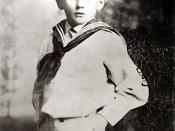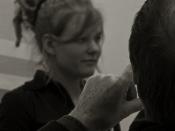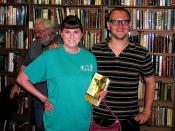1
Bourke
Casandra Bourke
Julie Lewis
Eng 101 Sect 1399
September 20th, 2007
The Boundaries of Adolescence
Growing up is an important and difficult part of a person's life. In the story "Araby," author James Joyce describes the necessary act of maturing with a self-conscious ease. As he narrates his trials as a young boy who is discovering his awkward feelings and newfound emotions, Joyce paints an image of this difficult age and the boundaries that encompass it. Using references of physiological and solid boundaries through contrast of light and dark, adoration, and fear, Joyce describes his embarrassing transformation into adolescence.
In "Araby," Joyce uses the contrast of light and darkness to show an internal and external boundary that is apparent in his life. The author describes his home with morose words and morbid references back to a priest that had died in one of the rooms.
He also describes the school as inhibiting. However, when the boys are set free from their prison of an education, Joyce writes how, "â¦we played until our bodies glowed. Our shouts echoed in a silent street." The adult world seems dark and diluted, whereas when the boys are allowed to act like children - they glow with light and brightness. The children would also remain hidden in shadows while watching for adults. A wall of curiosity and darkness blocks them from becoming comfortable with the more elderly people in the story. This contrast of light and dark represents the difference and barrier between being a child and becoming an adult.
Joyce also showed the boundaries of adolescence through his awkward and uncomfortable way of dealing with a crush. The author is terrified about approaching Mangan's sister, and is extremely frustrated with his emotions. He tends to hide and crouch...


